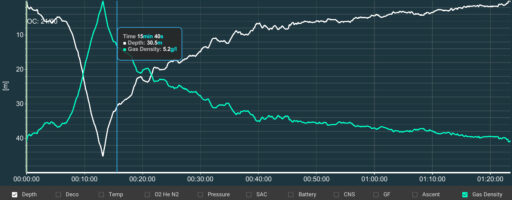Gas Density – An Important Consideration (CO2 Retention)
June 22, 2023
Whilst I won’t go into too much detail about the depths I’ve ventured to as an experienced diver, I will say for sure that I’m certified beyond 30m. During excursions within this realm, I noticed on several occasions, when using air or nitrox as a bottom gas, I would become light headed and have bouts of anxiety creep in. At first I simply shrugged this off as the well documented narcosis from nitrogen, however I would later learn the true cause…
CO2 Retention
As we already know (hopefully) as part of the respiration process, during each breath, we on-gas Oxygen, to be transported around the body, and off-gas Carbon Dioxide as a result of metabolising Oxygen and generating energy. This process happens easily at rest and is more than covered by the rate at which we breath when relaxed. Under more demanding circumstances (for example during exercise) our body generates significantly more CO2 from cells metabolising O2, which in turn, requires more gas volume to pass over the alveoli in our lungs – hence our brain signals us to breath progressively heavier to cope with the rising CO2 levels (a feedback loop). On dry land, this feedback loop performs well, however for some of us, when submerged (i.e Scuba diving) this feedback loop becomes interrupted, and our breathing rate (and / or depth of each breath) does not increase accordingly with the levels of CO2 in our blood. This is what is known as a “CO2 retainer” and unfortunately, I happen to be one. Most of us have heard of someone complaining of a headache during or shortly after a dive, which subsequently dissipates – there’s a high chance this is due to CO2 retention, especially if the diver was working moderately or above on the dive due to current / stressful situations etc. or perhaps they were just trying to breathe less in an attempt to conserve gas and keep up with buddies consumption (which I do not recommend!).
Spotting CO2 retention symptoms
Common symptoms during the dive are:
- Hyperventilation
- Shortness of breath and tachycardia (rapid heart beat)
- Headache and excessive sweating
- Nausea
- Mental impairment
- Unconsciousness (the final stage)
Some symptoms such as Nausea and Headache can persist after the dive, but usually resolve shortly after.
Gas Density & it’s effect on CO2 Retention
As mentioned above, the alveoli in our lungs are responsible for the exchange of O2 and CO2 between the gas surrounding them and our blood. The problem is, as we increase the density of the gas in our lungs, this starts to have an effect on the partial pressures that allow normal gas exchange – the partial pressure of CO2 in your blood is normally around two magnitudes larger than that of the gas you breath in. As the gas density increases, so too does the effective partial pressure of any CO2 in that gas, effectively closing the gap between the two partial pressures – slowing down CO2 elimination from the blood. The result is rising CO2 levels in the blood – not a good thing!
Preventing CO2 Retention by keeping gas density down
Taking into account that work of breathing (WOB) is normally increased to varying degrees depending on the type of regulator / rebreather used, and the possibility of increased workload during a dive, DAN (Divers Alert Network) have released new recommendations suggesting an ideal maximum density of 5.2g/L – which translates to around 31m in sea water using normal air or nitrox. Technical divers can start to use less dense gasses (such as helium) to bring the gas density down to acceptable levels, but for the rest of the recreational dives, sticking to 31m or less is highly advised.
Further Thoughts on CO2 Retention
Besides Gas density (and good dive planning!) there are a number of other practices we can use to minimise the chances of retaining CO2:
- Keep equipment related WOB to a minimum by using regularly serviced, high performing regulators
- Minimise workload during the dive by avoiding swimming against currents where possible
- Ensure proper breathing by taking long, deep inhales followed by slow calm exhales – maximising gas throughput in the lungs
- Avoid breath holding (common sense but especially on the exhale)
- Be aware of your breathing habits vs workload (don’t try and keep your breathing rate low despite working hard!)
- Ensure you work on your cardiovascular fitness often
- Just as important as plan your dive, dive your plan!
For me, as a “CO2 Retainer” I have to be particularly mindful of my breathing both at depth and during work, since my system doesn’t always increase my breathing rate automatically. Since being more mindful, and making changes to the way I breathe during dives, I’ve yet to have another issue related to CO2 retention – issues I’m not planning on experiencing again in the future.
For further information on Gas Density and CO2 Retention, check out DAN’s recently published article here: https://dan.org/alert-diver/article/performance-under-pressure


